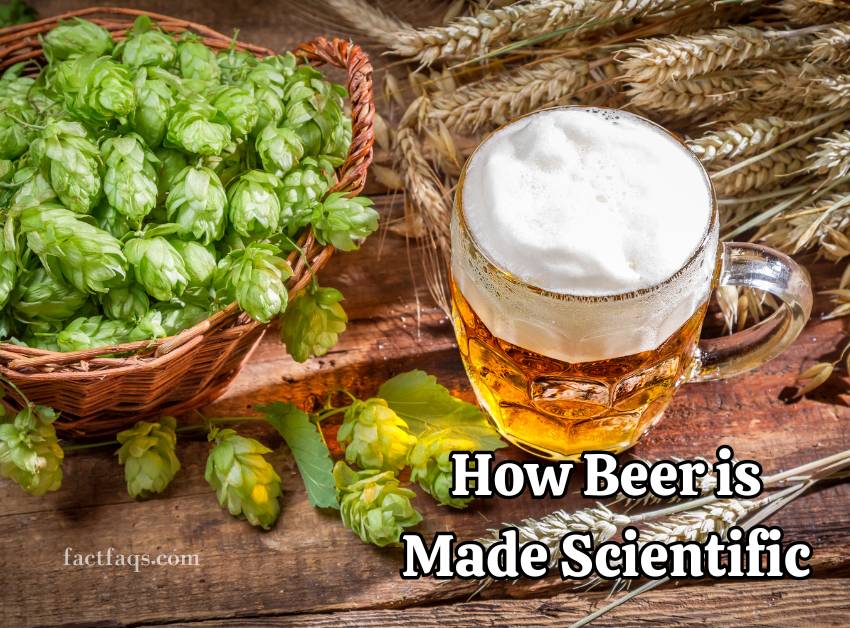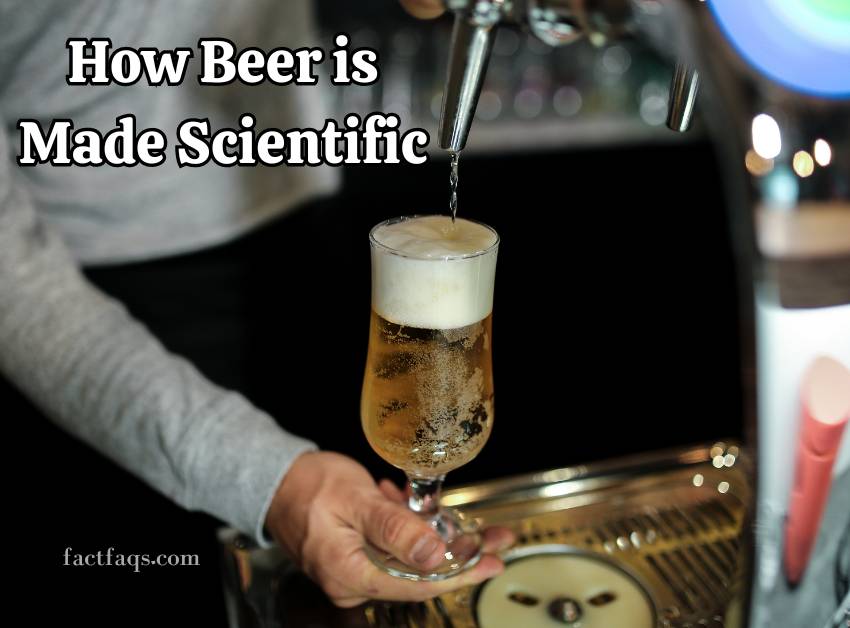Beer is made through fermentation, a process where yeast converts sugars into alcohol and carbon dioxide. The main ingredients are water, malted grains, hops, and yeast.
Crafting a perfect pint of beer merges science and art, stirring interest and taste buds across the globe. The journey of beer begins with malting, where grains, typically barley, are soaked and sprouted to unlock sugars. Brewing is next, whereby the malt is mashed with water to create wort, a sweet liquid.
Hops are then introduced for flavor and bitterness, balancing the malt’s sweetness. The magic of fermentation brings the concoction to life, as yeast feasts on the sugars, giving rise to alcohol and imparting distinctive beer flavors. From ales to lagers, the variety in brewing methods and ingredients concocts an array of beers to suit any palate. This fascinating alchemy, honed over centuries, continues to thrive as a beloved craft and science, catering to a world thirsty for tradition and innovation.
Unveiling Beer’s Origins

The journey of beer from ancient times to modern days is a fascinating tale of human ingenuity. Archaeological evidence suggests that the earliest records of beer production date back to around 5,000 BCE in what is now Iran, with further instances across various ancient civilizations including Mesopotamia and Egypt. These early batches were often artisanal concoctions using native grains, which varied widely in flavor and potency.
The evolution of brewing techniques is marked by significant milestones through the ages. During the Medieval period, monks and monasteries became the custodians of beer-making knowledge, refining brewing processes and contributing to the diversity of styles. The Industrial Revolution then introduced mechanized brewing and consistency in production. In the 19th century, the discovery of yeast’s role in fermentation by Louis Pasteur revolutionized beer brewing, leading to the science-driven craft we know today.
Essential Beer Ingredients Explored
Beer brewing is an intricate process hinged on four fundamental ingredients: water, malted grain (usually barley), hops, and yeast. The character of beer is primarily shaped by these components, with water being the main constituent that acts as a solvent for the flavors. Malted barley is pivotal for its enzymes, which convert the grain’s starches into fermentable sugars, crucial for alcohol production.
Hops are known for contributing a bitter edge and aromatic qualities, balancing the malt’s sweetness while also lending preservative properties. Yeast plays a critical role in fermentation, converting sugars into alcohol and carbon dioxide, and influencing the beer’s flavor and aroma profile.
Different beer styles emerge from the variations in these core elements. For example, the type of grain, such as wheat or rye, the hop variety, the water profile, and the yeast strain can all affect the taste, aroma, color, and mouthfeel of the beer.
The Science Behind Malting
Malting plays a pivotal role in beer production, transforming barley or other grains into malt, which is the backbone of flavor and fermentable sugars in brewing. This process begins with steeping, where grains are soaked in water to initiate germination. It continues with germination, a stage where enzymes become active and start converting stored starches into sugars. Finally, kilning ceases germination by carefully drying the malt, creating a rich tapestry of flavors and colors.
The primary purpose of malting is to unlock the grain’s potential, providing essential enzymes and sugars necessary for yeast fermentation later in the brewing process. Properly malted grains contribute to the beer’s overall character, affecting its color, taste, and mouthfeel. Through this blend of art and science, brewers can craft a diverse range of beers, each with its unique profile.

The Art Of Mashing
The Art of Mashing is a critical step in brewing where enzymatic conversion plays a key role in transforming starches into fermentable sugars. This process occurs in a controlled environment where temperature is meticulously maintained to favour specific enzymes.
Each enzyme active during the mashing process has an optimal temperature range, affecting the type and amount of sugars produced. These sugars contribute to the final beer’s flavour profile and alcohol content. Utilizing various temperatures, brewers can manipulate the mashing stage to create a desired sugar profile, leading to different beer characteristics.
Boiling And Hops Addition
Boiling plays a critical role in the beer-making process. It serves multiple functions, such as sterilization of the wort to ensure no unwanted microbes spoil the batch. Moreover, it aids in the evaporation of unwanted volatiles, which could otherwise impact the flavor profile negatively. This step also extracts the important bittering, flavoring, and aromatic compounds from the hops.
Understanding the timing of hops addition is essential as it affects the final beer’s taste and aroma. Early additions contribute to bitterness, while late in the boil, hops impart more flavor and aroma. This delicate balance is what brewmasters aim to perfect to create a beer that delights the senses.
Hops not only influence the beer’s bitterness but also add a complex bouquet of aromas ranging from citrusy to pine notes, depending on the hop’s variety. These aromatic compounds, once unlocked during the boil, become an integral part of the beer’s character, giving each brew a distinctive identity.
Yeast And Fermentation Wisdom
Selecting the right yeast strain is crucial for the beer-making process, as it can significantly affect the flavor and quality of the beer. Brewers often choose yeast strains that best complement their beer’s desired profile, whether it’s a fruity ester or a clean, crisp finish. The yeast not only converts sugars into alcohol but also imparts unique characteristics that are specific to the strain used.
The fermentation timeline is another key component in crafting beer. This process, which can last from several days to weeks, is closely monitored to ensure optimal conditions for the yeast. The length of fermentation varies depending on the beer style and the specific yeast strain, with temperature control being an essential factor in regulating the fermentation speed.
Understanding the by-products of fermentation is vital for brewers to manage their impact on the final product. Compounds such as diacetyl, acetaldehyde, and sulfur compounds can influence the taste and aroma of the beer, sometimes undesirably. Brewers must balance these elements to achieve the right flavor profiles, using techniques to mitigate any negative effects while enhancing positive ones.
Clarification And Conditioning
Clarification and conditioning are pivotal in the production of quality beer. Techniques to achieve clarity include filtration, which strips away sediment and yeast, and fining agents, substances added to coagulate and settle particulates. Modern brewers also employ centrifugation, which separates solids from liquids through rapid rotation.
The role of conditioning extends beyond clarity, improving flavor stability and maturation. During this phase, the beer undergoes essential chemical processes, resulting in a rounded and balanced end product. Notably, the duration of conditioning can significantly influence the depth and complexity of beer’s flavor profile.
Bottling, Kegging, And Beyond
Packaging beer is a critical step in the brewing process, where the beverage is prepared for distribution and consumption. Different methods such as bottling and kegging are employed to ensure the quality and preservation of the beer. Bottling involves filling sterilized bottles with beer and sealing them with caps, whereas kegging requires transferring the beer into stainless steel kegs that are often used in bars and restaurants. Both methods aim to maintain the beer’s freshness and carbonation levels.
Speaking to carbonation, two primary techniques are prevalent: natural and forced carbonation. Natural carbonation occurs when yeast ferments residual sugars in the beer, creating CO2 in the process. On the other hand, forced carbonation involves saturating the beer with CO2 under pressure. This method is quicker and allows for more precise control over the resulting carbonation level. Mastering these techniques is essential for achieving the desired taste and effervescence unique to each style of beer.

Innovations In Modern Brewing
The brewing industry is embracing innovative technologies to enhance the quality and efficiency of beer production. Automated brewing systems facilitate precise control over temperature and timing, vital for consistency and flavor. AI-based predictive analytics help brewers anticipate and adjust to market demands or process variables, significantly reducing waste and improving production planning.
Sustainability is deeply integrated into modern brewing practices. Water reclamation processes, for instance, are being honed to reduce consumption, while energy recovery systems harness heat generated during brewing, lowering carbon footprints. Brewers are increasingly turning to local ingredients, minimizing transportation and supporting local economies.
| Innovation/Technology | Environmental Benefit |
|---|---|
| Automated brewing systems | Enhanced process efficiency and resource conservation |
| AI-based analytics | Optimized production and reduced waste |
| Water reclamation | Lowered water usage |
| Energy recovery | Decreased energy demand and carbon emissions |
Home Brewing Versus Commercial Brewing
Homebrewers and commercial breweries diverge significantly in their beer-making processes. The scale of production greatly influences the techniques and resources available. Home brewers often revel in the hands-on approach, crafting unique beers in small batches. This allows for a high degree of customization and experimentation. On the flip side, commercial breweries implement large-scale operations, employing sophisticated machinery to ensure consistency and efficiency.
Nevertheless, both face their own set of challenges. Homebrewers might struggle with limited equipment and lack of quality control measures, which can lead to inconsistency in flavor and quality. In contrast, commercial breweries must navigate strict industry regulations and market competition. They tend to have an advantage in consistency due to their controlled brewing environment and advanced technology.
| Aspect | Home Brewing | Commercial Brewing |
|---|---|---|
| Scale | Small, personal batches | Large-scale production |
| Equipment | Basic, sometimes DIY | Advanced, automated systems |
| Customization | High – can easily tweak recipes | Low – consistency is key |
| Challenges | Quality control, equipment limitations | Regulations, market pressures |
| Advantages | Creativity, personalized batches | Efficiency, product consistency |
Advancements In Brewing Safety And Quality Control
Quality control is crucial in the brewing process, ensuring consistency, safety, and flavor accuracy in every batch of beer produced. State-of-the-art monitoring systems and stringent protocols are now integral to the beer production workflow. By leveraging these advancements, breweries safeguard against contamination, which could otherwise lead to spoilage or health hazards. Advanced testing methods, including chromatography and spectrophotometry, are applied to assess the chemical and biological composition of the brew, offering precise control over the resulting beverage.
Technological innovations have greatly enhanced safety practices for brewers and consumers alike. Automated systems have decreased the reliance on manual handling of hazardous materials, while sophisticated detection equipment permits early warning signs of any aberrations that could compromise safety. This proactive approach ensures that every bottle or can of beer not only meets the regulatory standards but also aligns with the expectations of a quality-conscious market.
The Sensory Experience Of Beer
The brewing process plays a pivotal role in shaping the taste and aroma of beer. Variables such as malt roasting levels, hop variety, and fermentation intricacies come together to create a symphony of flavors and scents. Diving into beer-tasting notes, enthusiasts seek to identify characteristics ranging from bitterness and sweetness to fruitiness and spiciness. Profound understanding allows for appreciating subtle notes, which could include hints of caramel, citrus, or pine derived from specific ingredients used during brewing.
To perceive these nuances effectively, a systematic approach is recommended. This involves observing the beer’s appearance, swirling to release aromas, sniffing to detect the primary and secondary scent notes, and finally, tasting to explore the flavor profiles. Consistent practice and exposure to diverse beer styles can enhance one’s ability to discern and enjoy the complex sensory experience of beer.
Frequently Asked Questions For How Beer Is Made Scientific
What Are The Basic Ingredients In Beer?
The basic ingredients in beer include malted grains (usually barley), hops, yeast, and water. Each ingredient plays a crucial role in flavor, fermentation, and the beer’s final character.
How Does The Brewing Process Work?
The brewing process involves malting, mashing, boiling, fermenting, conditioning, and packaging. Malt is soaked, germinated, dried, then mashed with hot water. Extracts are boiled with hops, and cooled, then yeast ferments the mixture into beer.
What Role Do Hops Play In Beer Making?
Hops contribute bitterness to balance sweetness, provide aroma and flavor, and possess antibacterial properties that benefit the brewing process. They are essential for the characteristic taste of many beer styles.
Can Beer Be Made Without Hops?
Yes, beer can be made without hops. While not common, some historical or alternative brews use other plants for bitterness and flavor, such as herbs or spices in a style known as gruit.
Conclusion
Understanding the scientific intricacies behind beer production enriches one’s appreciation for this ancient beverage. We’ve explored the journey from grain to glass, revealing the chemistry that creates such diverse flavors. Embrace this knowledge the next time you savor a cold brew, recognizing the art and science in every sip.
Cheers to the fusion of tradition and technology that continues to innovate in the world of beer making.
